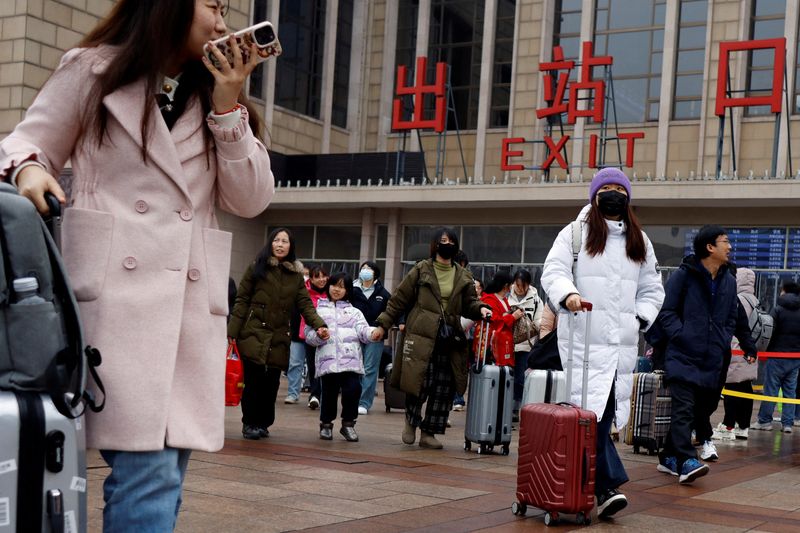
© Reuters. Travellers walk with their luggage outside the Beijing railway station during the Spring Festival travel rush following the eight-day Lunar New Year holiday, in Beijing, China February 18, 2024. REUTERS/Florence Lo
USD/CNY
0.00%
Add to/Remove from Watchlist
Add to Watchlist
Add Position
Position added successfully to:
Please name your holdings portfolio
Type:
BUY
SELL
Date:
Amount:
Price
Point Value:
Leverage:
1:1
1:10
1:25
1:50
1:100
1:200
1:400
1:500
1:1000
Commission:
Create New Watchlist
Create
Create a new holdings portfolio
Add
Create
+ Add another position
Close
BEIJING (Reuters) -Tourism revenues in China during the Lunar New Year holidays that ended on Saturday surged by 47.3% year-on-year thanks to a domestic travel boom amid a longer-than-usual break, official data showed on Sunday.
The data may offer temporary relief to policymakers as the world’s second-largest economy has been facing deflationary risks amid weak consumer demand, but the sustainability of the tourism boost remains uncertain.
During the holiday, known as the world’s largest annual migration, tourist attractions across the country witnessed massive crowds.
Domestic tourism spending jumped by 47.3% to 632.7 billion yuan ($87.96 billion) from the same holiday period in 2023, according to the data by the Ministry of Culture and Tourism.
The number of domestic trips made during this year’s holiday grew by 34.3% from a year ago, totalling 474 million.
Compared to the 2019 Lunar New Year holiday before the COVID pandemic struck the country, domestic tourism spending rose 7.7% and domestic trips increased 19%, according to the ministry’s data.
But the holiday in 2024 lasted for eight days, one day more than the Lunar New year break in 2019.
The ministry did not give a breakdown of the number of trips and tourism spending by day.
Nonetheless, in absolute terms, the longer holiday this year boosted overall spending.
The holiday, also called the Spring Festival, is traditionally the time hundreds of millions of people return to their hometowns by air, train or road to reunite with family members.
For international travels, China witnessed around 13.52 million inbound and outbound trips during the holiday, growing by 2.8 times from the same holiday period last year, according to the National Immigration Administration.
The total entry-exit trips during the holiday returned to 90% of the 2019 levels, according to the administration.
As film watching becomes one of the most popular entertainment activities during the holiday, the country’s box office revenue exceeded 8 billion yuan ($1.11 billion) over the eight days, according to the China Film Administration, marking a new record high.
The economy has been grappling with multiple challenges including a property downturn and sluggish demand since last year, forcing policymakers to cut interest rates to spur growth even as many developed economies were focused on taming stubbornly high inflation.
As authorities are striking a delicate balancing act to support the economy at a time when signs of deflationary pressures call for more stimulus measures, China’s central bank left a key policy rate unchanged on Sunday when rolling over maturing medium-term loans.
($1 = 7.1929 Chinese yuan renminbi)
Source: Investing.com




























